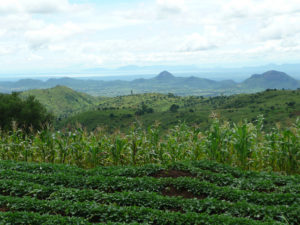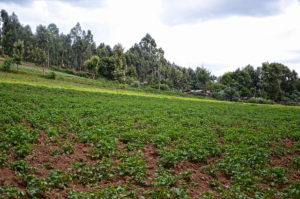Agroforestry landscapes cover 1 billion hectares of land worldwide and make a significant contribution to the overall health of the planet.
The introduction of trees to farms and landscapes for multiple productive purposes could play a key role in mitigating the impact of climate change by potentially contributing to more than 1.5 billion hectares of mosaic land restoration, said a CGIAR Research Program on Forests, Trees and Agroforestry (FTA) expert speaking at the Global Landscapes Forum (GLF) in Bonn, Germany.
“Agroforestry provides some of the greatest opportunities for emission reductions and potential carbon neutrality in agriculture — carbon benefits,” said Peter Minang, leader and global coordinator of landscapes governance at the World Agroforestry Centre (ICRAF), adding that a huge emissions reduction saving can be achieved by increasing agroforestry landscapes, which sequester carbon.
Land restoration was part of a global plan for meeting targets agreed at UN climate talks in 2015. The aim is to limit global temperature increases to well below 2 degrees Celsius and to pursue efforts to limit increases to 1.5 degrees Celsius. For example, more than 80 percent of activities to restore degraded land in Kenya will focus on tree-based or agroforestry systems, according to ICRAF.
Watch: Agroforestry in landscape restoration for livelihoods, climate and ecosystem services
Several large-scale forest restoration projects have been launched to meet a target to restore 350 million hectares of land in accordance with the Bonn Challenge. The African Forest Landscape Restoration Initiative (AFR100) aims to help achieve the target by restoring 100 million hectares in Africa.
The practice, which can include scattered trees on farmland, intercropping, home gardens, tree crop systems — is increasingly popular on all continents, with 1.2 million people engaging in agroforestry worldwide, Minang said.
Agroforestry leads to better soil fertility, and contributes to improved nutrition by boosting dietary options, but finding financial backing for large-scale projects can be difficult.
In line with this, ICRAF hosted a session at the GLF, along with with Humanist Institute for Co-operation with Developing Countries (HIVOS) and FTA, titled Agroforestry in landscape restoration for livelihoods, climate and ecosystem services.

Inspired by the Sustainable Development Goals, the session focused on the accomplishments and future of agroforestry as a path toward sustainable landscape restoration. By offering a route to reconciliation between the frequently competing claims of agriculture and reforestation, agroforestry is playing an increasingly central role in policymaking.
Aiming to achieve an exchange of knowledge on ecosystem functionality, biodiversity, livelihoods and climate change, the forum demonstrated the potential dividends for human wellbeing offered by landscape restoration in developing countries.
Read also: Good investments in agriculture and forestry can benefit smallholders and landscapes
THEORY TO PRACTICE
Working with the private sector and local government in China’s Yunnan province, ICRAF collaborated on a major restoration project that converted a large-scale site degraded by mining into a lush green productive mosaic landscape bolstered by a profitable mushroom trade.
“It’s a tremendous transformation — it’s a really good restoration of multiple services, Minang said. “Mushrooms are being cultivated underneath the tree systems — high value mushrooms, highly economically valuable, but also generating jobs and linking to the market.”
The area also produces timber, fruit, tea, oil, flowers, spices and medicine.
Meanwhile, a restoration project offering multiple socioeconomic benefits to an area degraded by cattle grazing in the Shinyanga region of Tanzania now features almost 380,000 hectares of trees due to a local process known as ngitili, which protects certain areas from grazing.
“The two case studies illustrate there is broad potential,” Minang said.

Read more: FTA scientists feature in innovative series of talks on landscapes
To fully realize their potential, agroforestry projects must attract more investment and financing, quality planting material, locally appropriate options, relevant incentives, and methods for monitoring agroforestry in restoration projects to implement large-scale transformation, he said.
“We need enabling policies and good governance,” he explained.
WHERE TO IMPLEMENT?
In the latter part of the discussion forum at GLF, ICRAF scientist Roeland Kindt introduced a new publication titled Suitability of key Central American agroforestry species under future climates: an atlas
The atlas provides habitat suitability maps for 54 species that are widely used in Central America for shade in coffee or cocoa agroforestry systems. The 54 species represent 24 fruit species, 24 timber species and six species used for soil fertility improvement. It was developed to support climate change oriented initiatives for diversification and conservation of forest genetic resources across Central America.
The authors expect that farmers, scientists and technicians will be able to use the atlas to identify suitable and vulnerable areas for shade species and develop strategies for climate change adaptation.
Read also: Suitability of key Central American agroforestry species under future climates: an atlas
Adapted from the article written by Julie Mollins, originally published by GLF’s Landscapes News.
This research forms part of the CGIAR Research Program on Forests, Trees and Agroforestry (FTA), which is supported by CGIAR Fund Donors.











